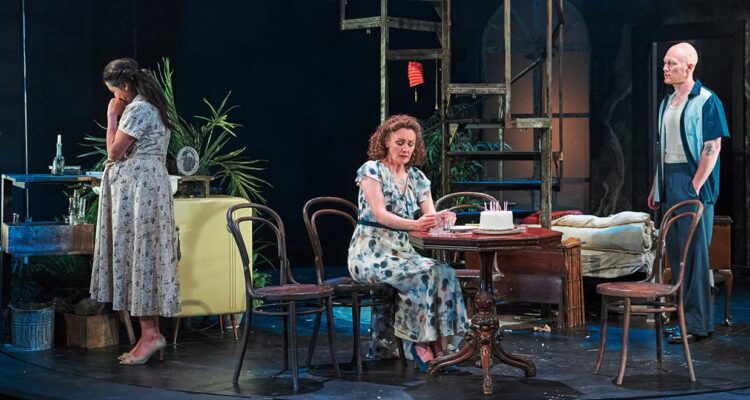There are always challenges to producing a play as well-known and well-worn as Tennessee Williams’ A Streetcar Named Desire, especially given the playwright’s very specific stage directions. All the more so when that play has a particular, defining image in the public mind. For many, Marlon Brando in a tight white t-shirt yelling ‘Stellaaa’ simply is Streetcar.
Elizabeth Newman’s production, originating at the Pitlochry Festival Theatre last year, struggles to escape these constraints or bring a distinctive take to this classic. The story of faded southern belle Blanche DuBois moving into the cramped New Orleans home of her sister Stella and brutish brother-in-law Stanley Kowalski remains firmly rooted in productions that have come before.
While the direction is unadventurously conventional, and lacks power and tension at crucial moments, the set design is strikingly delivered by Emily James. She places Stella and Stanley’s home in a courtyard crowded with fountains and greenery, constantly overlooked by winding stairs and balconies.
The action takes place on an oversized jazz record that turns periodically as if on a turntable (perhaps taking its cue from the rotating stage in the critically acclaimed 2014 production at the Young Vic), shrinking the action and heightening the claustrophobic air. Each turn of the set gives the audience a new angle to peer in at the disintegrating Blanche, and acts as a metaphor for the tragic carousel of her life.
The lighting and music (by Jeanine Byrne and Pippa Murphy respectively) are intense windows into Blanche’s deteriorating state of mind. Woozy jazz draws us into the world of 1940s New Orleans, fracturing in the second act along with Blanche’s grasp on reality. Disorientating flashes of light streak across the auditorium.
Kirsty Stuart is superb as Blanche herself, the fragility immediately visible under her apparently poised exterior. Despite Blanche’s vanity and neediness, Stuart encourages the audience to care for her and sympathise with a woman struggling under the weight of a fate she cannot control. She delivers Blanche’s flights of fantasy – ‘what the truth ought to be’ – with conviction, and her doomed liaison with lonely, hopeful Mitch (Keith Macpherson) is a tragedy we fully invest in.
Unfortunately, not all of the acting is so successful. It is possible to forgive the somewhat erratic nature of some of the accents. More problematic is Matthew Trevannion’s Stanley, who never quite masters the complex blend of physical threat and sexuality that is crucial to the role. It is hard to see this Stanley exerting the requisite fascination on both Stella and Blanche, or to believe his shouty flashes of violence. The animal energy within him should constantly fizz like a building promise of lust or anger, not suddenly explode like a surprise.
There are always good reasons for staging A Streetcar Named Desire – the stiletto sharpness of the writing, the power of its tragic tale – but this show never convincingly makes the case for why we should be watching this particular production at this particular time. Instead, it leans comfortably into tradition and plays things straight. With a more persuasive Stanley and more heft to the direction, the ingredients are there for this to have been a powerful, if straightforward take on a classic. As it is, it leaves the audience feeling somewhat underwhelmed.
Performed at The Royal Lyceum Theatre, Edinburgh
Running time: 2 hours 50 minutes, including interval
Runs until Saturday 9 November October, 19:30 Tuesday-Saturday, 14:30 Wednesdays and Saturdays
Written by Tennessee Williams
Directed by Elizabeth Newman
Designer: Emily James
Composer: Pippa Murphy
Lighting Designer: Jeanine Byrne
Cast: Nalini Chetty, Oliver Cookson, Deirdre Davis, Keith Macpherson, Patricia Panther, Marc Small, Kirsty Stuart, Matthew Trevannion, Jesse Fox

